Слайд 2Outline
I. Basic Pathophysiology
II. Describing murmurs
III. Systolic murmurs
IV. Diastolic murmurs
V. Continuous murmurs
VI. Summary

Слайд 3Basic Pathophysiology
Murmurs = Math
Q = V*A
Q = P/R
NR = d*D*V/n
Therefore:
Inc. P =>

Inc. V => Inc. NR
Systolic Diastolic
Слайд 4Describing a heart murmur
1. Timing
murmurs are longer than heart sounds
HS can distinguished

by simultaneous palpation of the carotid arterial pulse
systolic, diastolic, continuous
2. Shape
crescendo (grows louder), decrescendo, crescendo-decrescendo, plateau
3. Location of maximum intensity
is determined by the site where the murmur originates
e.g. A, P, T, M listening areas
Слайд 5Describing a heart murmur con’t:
4. Radiation
reflects the intensity of the murmur and

the direction of blood flow
5. Intensity
graded on a 6 point scale
Grade 1 = very faint
Grade 2 = quiet but heard immediately
Grade 3 = moderately loud
Grade 4 = loud
Grade 5 = heard with stethoscope partly off the chest
Grade 6 = no stethoscope needed
*Note: Thrills are assoc. with murmurs of grades 4 - 6
Слайд 6Describing a heart murmur con’t:
6. Pitch
high, medium, low
7. Quality
blowing, harsh, rumbling, and

musical
8. Others:
i. Variation with respiration
Right sided murmurs change more than left sided
ii. Variation with position of the patient
iii. Variation with special maneuvers
Valsalva/Standing => Murmurs decrease in length and intensity
EXCEPT: Hypertrophic cardiomyopathy and Mitral valve prolapse
Слайд 7Systolic Murmurs
Derived from increased turbulence associated with:
1. Increased flow across normal SL

valve or into a dilated great vessel
2. Flow across an abnormal SL valve or narrowed ventricular outflow tract - e.g. aortic stenosis
3. Flow across an incompetent AV valve - e.g. mitral regurg.
4. Flow across the interventricular septum
Слайд 8Early Systolic murmurs
1. Acute severe mitral regurgitation
decrescendo murmur
best heard at apical impulse

Caused by:
i. Papillary muscle rupture
ii. Infective endocarditis
iii. Rupture of the chordae tendineae
iv. Blunt chest wall trauma
2. Congenital, small muscular septal defect
3. Tricuspid regurg. with normal PA pressures
Слайд 9Midsystolic (ejection) murmurs
Are the most common kind of heart murmur
Are usually crescendo-decrescendo
They

may be:
1. Innocent
common in children and young adults
2. Physiologic
can be detected in hyperdynamic states
e.g. anemia, pregnancy, fever, and hyperthyroidism
3. Pathologic
are secondary to structural CV abnormalities
e.g. Aortic stenosis, Hypertrophic cardiomyopathy, Pulmonic stenosis
Слайд 10Aortic stenosis
Loudest in aortic area; radiates along the carotid arteries
Intensity varies directly

with CO
A2 decreases as the stenosis worsens
Other conditions which may mimic the murmur of aortic stenosis w/o obstructing flow:
1. Aortic sclerosis
2. Bicuspid aortic valve
3. Dilated aorta
4. Increased flow across the valve during systole
Слайд 11Hypertrophic cardiomyopathy
Loudest b/t left sternal edge and apex; Grade 2-3/6
Does NOT radiate

into neck; carotid upstrokes are brisk and may be bifid
Intensity increases w/ maneuvers that decrease LV volume
Слайд 12Pansystolic (Holosystolic) Murmurs
Are pathologic
Murmur begins immediately with S1 and continues up to

S2
1. Mitral valve regurgitation
Loudest at the left ventricular apex
Radiation reflects the direction of the regurgitant jet
i. To the base of the heart = anterosuperior jet (flail posterior leaflet)
ii. To the axilla and back = posterior jet (flail anterior leaflet
Also usually associated with a systolic thrill, a soft S3, and a short diastolic rumbling (best heard in left lateral decubitus
2. Tricuspid valve regurgitation
3. Ventricular septal defect
Слайд 13Diastolic Murmurs
Almost always indicate heart disease
Two basic types:
1. Early decrescendo diastolic murmurs
signify
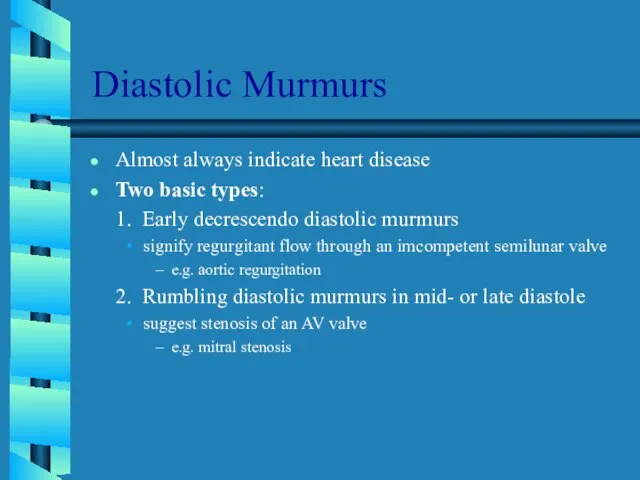
regurgitant flow through an imcompetent semilunar valve
e.g. aortic regurgitation
2. Rumbling diastolic murmurs in mid- or late diastole
suggest stenosis of an AV valve
e.g. mitral stenosis
Слайд 14Aortic Regurgitation
Best heard in the 2nd ICS at the left sternal edge
High
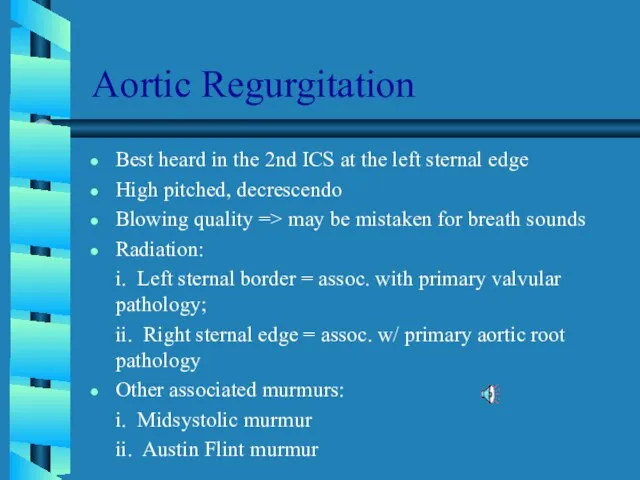
pitched, decrescendo
Blowing quality => may be mistaken for breath sounds
Radiation:
i. Left sternal border = assoc. with primary valvular pathology;
ii. Right sternal edge = assoc. w/ primary aortic root pathology
Other associated murmurs:
i. Midsystolic murmur
ii. Austin Flint murmur
Слайд 15Mitral Stenosis
Two components:
1. Middiastolic - during rapid ventricular filling
2. Presystolic - during
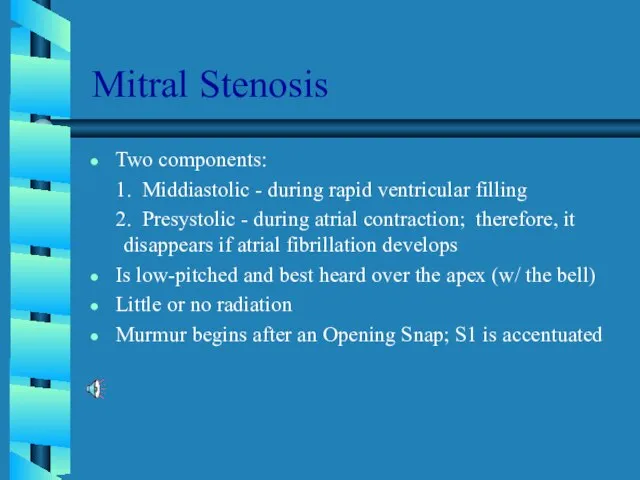
atrial contraction; therefore, it disappears if atrial fibrillation develops
Is low-pitched and best heard over the apex (w/ the bell)
Little or no radiation
Murmur begins after an Opening Snap; S1 is accentuated
Слайд 16Continuous Murmurs
Begin in systole, peak near s2, and continue into all or
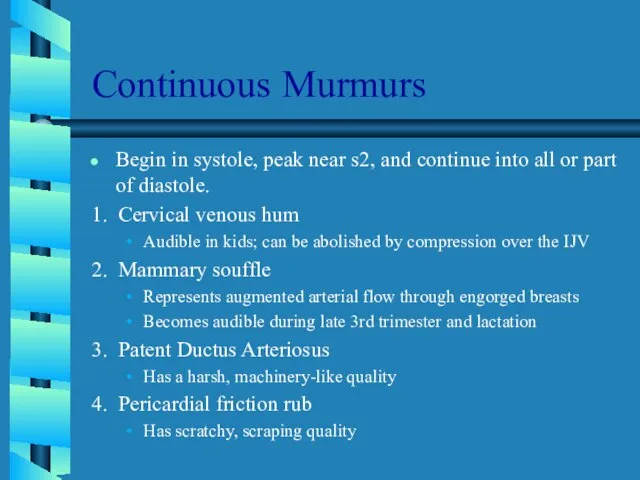
part of diastole.
1. Cervical venous hum
Audible in kids; can be abolished by compression over the IJV
2. Mammary souffle
Represents augmented arterial flow through engorged breasts
Becomes audible during late 3rd trimester and lactation
3. Patent Ductus Arteriosus
Has a harsh, machinery-like quality
4. Pericardial friction rub
Has scratchy, scraping quality
Слайд 17Back to the Basics
1. When does it occur - systole or diastole
2.
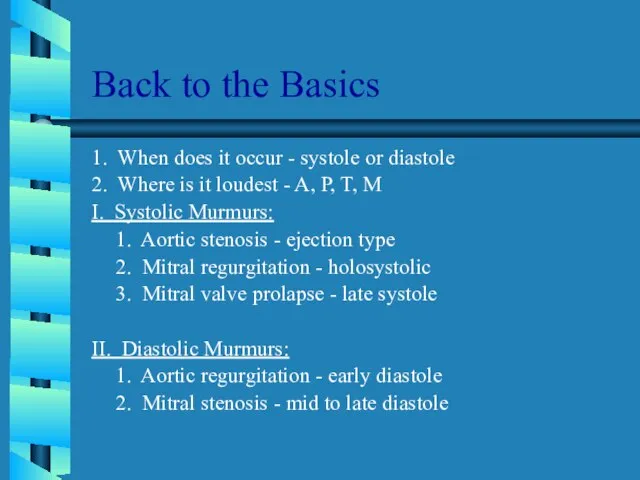
Where is it loudest - A, P, T, M
I. Systolic Murmurs:
1. Aortic stenosis - ejection type
2. Mitral regurgitation - holosystolic
3. Mitral valve prolapse - late systole
II. Diastolic Murmurs:
1. Aortic regurgitation - early diastole
2. Mitral stenosis - mid to late diastole
















 Векторы.
Векторы. Презентация на тему Колониализм в 16-19 веках
Презентация на тему Колониализм в 16-19 веках Презентация на тему Пирсинг
Презентация на тему Пирсинг Метод Фонетических Ассоциаций
Метод Фонетических Ассоциаций Бардовская песняПоэты-барды
Бардовская песняПоэты-барды Конституционный Суд РФ
Конституционный Суд РФ Романова Мария, визажист
Романова Мария, визажист Каждый специалист желает знать…
Каждый специалист желает знать… ГИА - 2012
ГИА - 2012 Эффективность работы системы дополнительного образования с целью повышения качества образования.
Эффективность работы системы дополнительного образования с целью повышения качества образования. горные породы
горные породы «Как правильно страховать, чтобы не получить проблемного клиента»
«Как правильно страховать, чтобы не получить проблемного клиента» Бег и ходьба. Чередование
Бег и ходьба. Чередование Основные пункты Правил Розничного рынка и других нормативных документов.
Основные пункты Правил Розничного рынка и других нормативных документов. Семья крепка ладом и укладом. Семейное благополучие глазами детей, 9 класс
Семья крепка ладом и укладом. Семейное благополучие глазами детей, 9 класс Кодирование звуковой информации
Кодирование звуковой информации Презентация на тему Решение задач - Треугольники
Презентация на тему Решение задач - Треугольники Manson McCall International Ltd Мэнсон МакКолл Интернешнл Лтд
Manson McCall International Ltd Мэнсон МакКолл Интернешнл Лтд Презентация на тему Тайга
Презентация на тему Тайга  Ya__LIChNOST (1)
Ya__LIChNOST (1) Успешные примеры внутренних коммуникаций в PwC Июнь 2010
Успешные примеры внутренних коммуникаций в PwC Июнь 2010 Петербург театральный, музыкальный и мир кино ВТОРАЯ ПОЛОВИНА XIX ВЕКА
Петербург театральный, музыкальный и мир кино ВТОРАЯ ПОЛОВИНА XIX ВЕКА НАГРЕВАНИЕ ПРОВОДНИКОВ ЭЛЕКТРИЧЕСКИМ ТОКОМ.КОРОТКОЕ ЗАМЫКАНИЕ.
НАГРЕВАНИЕ ПРОВОДНИКОВ ЭЛЕКТРИЧЕСКИМ ТОКОМ.КОРОТКОЕ ЗАМЫКАНИЕ. Спринг-эластика. Начни себя в гимнастике
Спринг-эластика. Начни себя в гимнастике Национальный вопрос и национальная политика
Национальный вопрос и национальная политика Маркетинг. Вводная
Маркетинг. Вводная ТОРГОВЫЕ АВТОМАТЫ
ТОРГОВЫЕ АВТОМАТЫ Техника бега на средние дистанции с низкого старта
Техника бега на средние дистанции с низкого старта